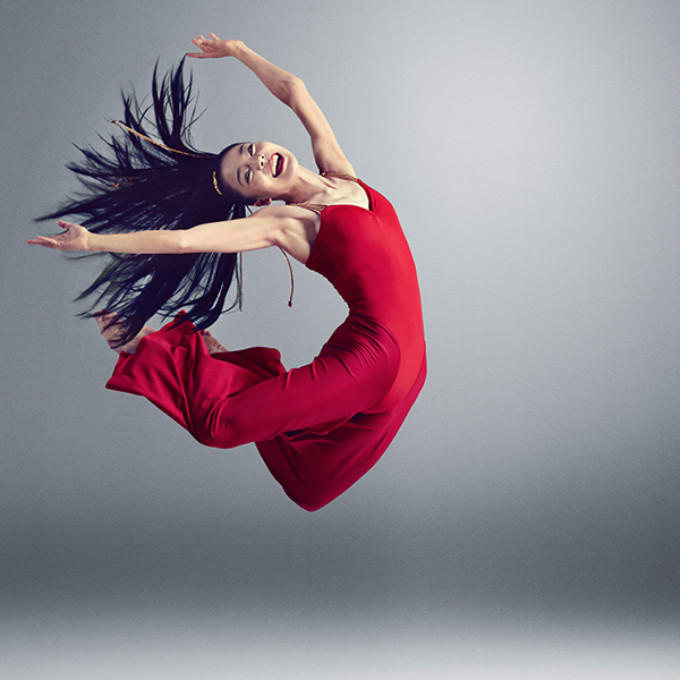Review: MARTHA GRAHAM DANCE COMPANY at Power Center For The Performing Arts

The Martha Graham Dance Company began with its Executive Director, LaRue Allen, explaining the dances for that evening to the audience in Ann Arbor, Michigan. In an era focused on making dance more accessible to a wider audience beyond New York, this was especially welcome.
The Martha Graham Dance Company, in its 93rd season, is the oldest dance company in America. And it's clear why the company has such staying power. Each dance conveyed stunning drama through movements which melded traditional ballet technique with gymnastics -- including a series of perfectly executed cartwheels -- and the unique athletic prowess the company is well known for.
Before the dancers took the stage, a moving clip of Martha Graham dancing filled a giant screen, alongside photos of a range of powerful women like Madeleine Albright, Oprah Winfrey and Michelle Obama. It was an innovative way to launch the evening's feminist theme that was carefully interwoven into many of the pieces.
The program started on a light note with Secular Games, which explores the subject of play and was choreographed by Maxine Doyle and Bobbi Jene Smith. A ball that the dancers toss back and forth throughout the dance is the focal point. It's hard not to be a bit preoccupied about one of the dancers literally dropping the ball amidst their complicated movements; it was particularly impressive that the dancers were able to continually pass and catch it. The ball almost became its own character in the way the dancers interacted with it. One particularly comic moment involved the way it served as a distraction for a female as she danced with her male partner, her eyes constantly drawn to it. I was consistently amazed at the ease with which the dancers executed the most complicated of movements, including one where the woman is suspended horizontally and perfectly flat while balancing on the shoulders of her male partner.
I was also wowed by the synchronicity among the dancers in each piece, especially in Deo, another piece choreographed by Doyle and Smith. In regimented rhythm, the dancers became one in each of their formations. They seem perfectly attuned to each others' bodies, moving seamlessly as a unit. Deo delves into the myth of the goddess of the earth, exploring such issues as fertility, loss, and grief. It opens with a stunning image, as fog fills the stage over dancers who remain still as corpses on their backs. Graham's trademark contraction moves are on full display when the women shake in unison, forming a cohesive circle, pained expressions on their faces during sad moments. It's a vivid, powerful image.
Lamentation Variations, conceived to commemorate 9/11, begins with a dramatic clip of Graham performing and includes a variety of short works. I particularly enjoyed the part towards the end where the full company danced together to form one bright hue of color combinations. Watching them lunge and glide in unison, accelerating together as the breathtaking classical music rose to a crescendo, was like witnessing a painting come to life. It was also striking the way the dancers were able to demonstrate grief so fully both through their movements and facial expressions.
The last piece, Chronicle, explores a prelude to war that progresses to a portrait of devastation in its wake. It was choreographed by Graham when she refused an invitation by Hitler to take part in the 1936 Olympic Games in Germany. It begins with Spectre, a powerful performance with one female commanding the stage, interacting with her billowing skirt that was used to often surround her and cover her head. In Steps in the Streets, women are adorned in long black dresses. Instead of their hair flowing long and carefree as in previous dances, it was tucked back tightly in a bun. The women are so pliable as they effortlessly move their arms and place them far over their shoulders. In this dance and the following movements of Chronicle, one is truly spellbound by the balletic moves they expertly perform, including strong, flawless leaps. The concluding movement, Unity -- Pledge to the Future, ends the evening with a powerful show of female force, when the women in the troupe dressed in black interact and surround a soloist in a white dress with a black stripe down the front. It's Martha Graham choreography at its best in the way it demonstrates the fierceness and power of women.
The costumes were a perfect complement to the dances. In Secular Games, childlike simplicity was conveyed through men wearing nothing but tights, while women wore plain striped leotards. In Deo, the women wore ethereal-looking, donning sheer outfits reminiscent of the characters in Greek mythology. Lighting also contributed to the riveting performance. Dances often began and ended with a dark stage around a single dancer, making for an effective dramatic device.
Spending the evening with the Martha Graham Dance Company consisted of far more than just being entertained by highly skilled dancers. The performance invited you to feel, think and be totally absorbed in a spectacle of movement and innovative choreography. In a Q and A following the performance, LaRue said that the company's intent is to provide an artistic experience that has a timeline and a purpose. That mission was definitely accomplished in this Ann Arbor performance.
Videos
